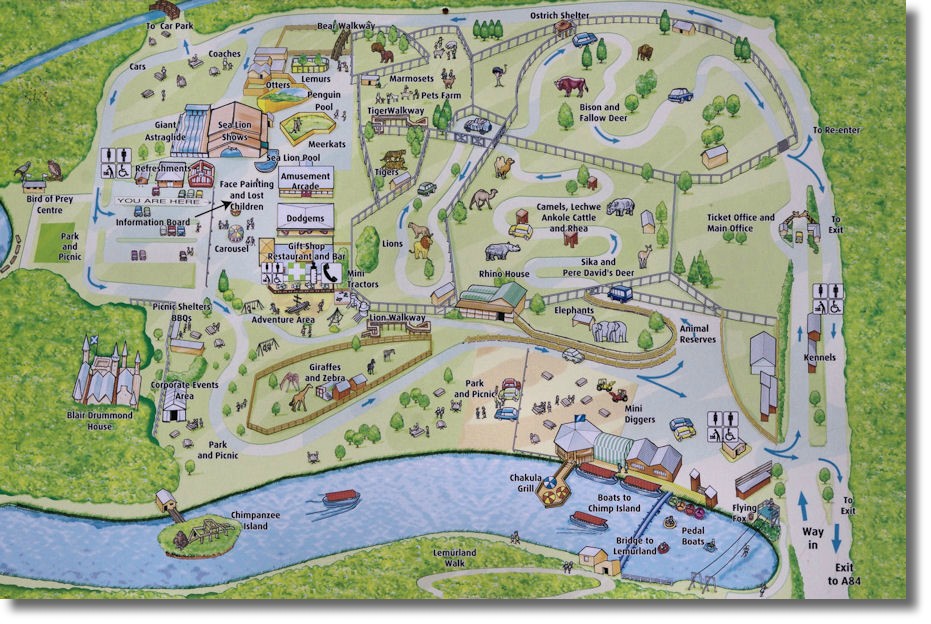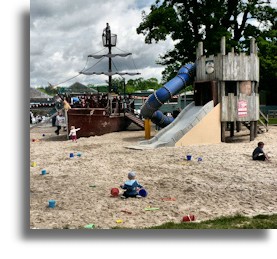
Map of Safari Park
Places to Visit in Scotland
- Blair Drummond Safari Park, Stirling

Map of Safari Park
Background
The Blair Drummond Estate was owned by Sir John Muir in the 1960s at a time when the increasing costs of maintenance made it imperative for such locations to find alternative sources of income. Some opened their doors to paying visitors but in 1966 the Marquesses of Bath created a Safari park attraction at his Longleat estate in Wiltshire in the south-west of England, where lions roamed freely as cars passed through their territory. Elizabethan Longleat House had been the first stately home to open to the public on a fully commercial basis back in 1949. Jimmy Chipperfield who owned the Chipperfield Circus had helped to create the Safari Park at Longleat and also became involved with creating Scotland's first (and so far, only) Safari Park at Blair Castle and it opened in 1970. Over the years the attraction has expanded the range of animals on view - many of them living in large, open enclosures where visitors can still get really close to them. The unique feature of driving past a pride of lions is still an important part of the visit to Blair Drummond. Initially, there was also a group of nearly 90 Rhesus macaque monkeys that lived in the drive through park but in the 1990's their tendency to damage car aerials led to them being moved to other zoos!
Conservation and breeding endangered species has become an important element of Blair Drummond. Rhinos, lions, giraffes, zebra, marmosets, ostriches and chimpanzees have bred successfully in the parkland. In 2000 a new Birds of Prey Centre was built and a range of raptors are now resident - and giving displays for visitors
When I first visited Blair Drummond I was taking my young children there but in recent years I haven't called there. But a visit by my two-year-old grandson and his parents, who live in the south of England, recently provided the perfect excuse to go round the Safari Park with a digital camera so that I could create this page and a slide show of graphics for the "Places to Visit" section of this Web site.
Layout
You can see the overall layout in the graphic of the information board at the top of this page. The park is spread over 120 acres but having arrived at the car park, most of the attractions and the animals are within an easy stroll (even propelling a child's push chair!) Most of the buildings such as restaurant, refreshments, amusement arcade and adventure play area and the building housing the sea lion shows are grouped near the car park. The areas where the lions and tigers are located (separately, of course) have high walkways nearby providing good views of the animals - their food is strategically placed to ensure that they are usually near these observation decks. And there are paved roads through the area allocated to the lions and another for Camels and Ankole Cattle , Rhea and Deer. Of course, cars must keep their windows closed - even these days now that the mischievous monkeys are long gone!
Animals
One of the aims of the Safari Park is to allow visitors to experience wild animals in a natural environment. Although inevitably they have to be fenced in and animals that bite have to be kept away from human fingers, you can get very close to a large number and in some cases, visitors can buy special food so that they can feed the animals. One of my memories of the recent visit was seeing the delight on my grandson's face when he touched the nose of a goat which it had pushed through the fence. The goat was not equally delighted, however, as Alex didn't have any of the hoped-for food!
Llamas and giraffes tower over adults so they must look like giants to a two-year-old whose previous experience of them has been as toys in a play-pen.
The Sea Lions didn't do any roaring and I did pause to think that how hard it must be for toddlers to learn that a Lion from the jungle is very different from a Sea Lion that swims in the water..!
Thanks to programmes on UK TV, there are few of us who have not come across the amusing Meerkats and Blair Drummond had a large extended family of delightful Slender-tailed Meerkats. Even though there was never going to be any danger coming from the sky or round a rock, there were still Meerkats designated to be on guard, as in the wild.Throughout the visit to Blair Drummond Safari Park I was grateful for the information boards beside each of the animals that not only provided the correct name for them but also gave lots of background facts about where they came from and their lifespan and feeding habits.
Big Cats
The Amur tiger, "Genghis" was a bit of a disappointment, however, as he appeared to be sound asleep. I thought perhaps he had been well fed at an earlier stage. It was only later, when I saw the picture I had taken of the tiger that I realised his eyes were open and looking straight at me...
The pride of lions looked - and sounded - far more impressive as the male lion gnawed away at a large piece of meat and the lionesses strolled around, a young lion cub in tow. We also got a bit of roaring from a couple of the lionesses in a dispute over food. Although the big cats were well fenced in, the high walkways on the edge of their territory allowed clear access for photography. I suspect that their food had been placed near those walkways and so I was pleasantly surprised at just how close we got for photography (admittedly with a good telephoto lens). I doubt if many folk who spend huge sums of money going on African Safari holidays would reliably get as close to lions and tigers as the visitors to Blair Drummond!
And of course there is also the opportunity to drive through the lion enclosure and get really close!
African Elephants
The African Savannah Elephants are the largest land mammal on earth and the Savannah elephant is the larger of the two species of African elephant. They can live for 70 years and male elephants weigh between 3,200 and 6,400 kilos (3.5 to 6.3 UK tons)
Once again it was possible to get really close to these huge animals - I was having to swop the telephoto lens for an ordinary one as I was too close to get all the elephant into the frame!
The three African elephants are getting a new house built for them as the current elephant house is no longer suitable and is in need of a makeover. The new house is to be next to the rhino house and will allow the elephants free access to the accommodation and outdoor section at all times and will also allow them to move freely within the house and interact with one another as and when they wish.
Chimp Island
Chimp island has been a major attraction since the early days of Blair Drummond Safari Park. Chimps cannot swim so once they were on the island for the summer, they couldn't get off. But Scottish summers rarely match the African ones so it was decided that they should be able to return to their winter quarters whenever they wanted. So in 2010 a bridge was constructed between their winter house and their island. it gives them all year-round access to both facilities and on pleasant winter days they can now wander over to the island for some exercise.
There is a frequent (free) boat trip for visitors which goes round the island and back to the jetty. Initially I was disappointed to find that there was a wire mesh on one side of the boat which made photography difficult. But when the member of staff controlling the boat pointed out that the chimps were often fond of throwing things at the boat as it sailed past I was grateful for the mesh, especially as over-ripe bananas were some of the more acceptable items that they are sometimes liable to aim at the boat - and us! Despite the wire mesh, I did even manage to get a photo of one of the chimps!
Blair Drummond House
Blair Drummond lies four miles to the northwest of Stirling and about a mile south of the village of Doune (and Doune Castle). A mansion was built on the estate in 1715 on a site which is now the giraffe enclosure. In the 18th Century, Blair Drummond was the home of Henry Home, Lord Kames (1696 - 1792), a Scottish advocate, judge, philosopher, writer and agricultural improver. He was a major figure of the Scottish Enlightenment and a founder member of the Philosophical Society of Edinburgh. The current three-storeyed baronial house was built in 1868-72.
Blair Drummond House itself is located on a mound overlooking the present Safari Park and provides an impressive back-drop. Unlike many such grand houses it is not open to the public - since 1977 it has been owned by the Camphill Trust who use it to care for the handicapped.

Other Entertainment and Facilities
These days, the full title of the estate is Blair Drummond Safari and Adventure Park. Quite apart from the adventure provided by the many wild animals, including entertainment provided by the Sea Lion Shows, the park has a giant "Astraglide", a "Flying Fox" slide where visitors are suspended beneath a wire which runs over the water and pedal boats below as they slide down at speed from one side to the other. There is also an adventure area with a wooden fort and galleon for kids to clamber over, dodgems, mini diggers and an amusement arcade. There's face painting for the kids and a large inflatable "bouncy castle" and a carousel. Many of these are free but some require an extra paymentOf course there is a restaurant (service is remarkably fast and there is a wide range of options) and a bar and a gift shop
Pictorial Slide Show
While this page has a number of illustrations of the animals and the facilities at Blair Drummond, I've also created a Web-based slide show of over 40 graphics of the Safari Park with thumbnails leading to larger versions of the pictures. The pages of larger graphics are also linked so that you can go through them as a slide show. See Slide Show - Blair Drummond Safari and Adventure Park.
More Information and How to Get There
Although most visitors get there by car, there is a regular bus service that runs from Stirling past the safari park operated by First Buses. For times and information see their web site at www.firstgroup.com.Blair Drummond is located less than an hour's drive from Glasgow or Edinburgh. Take junction 10 off the M9 and the Safari Park is signposted from the motorway on the A84. See also the Location Map (you can enlarge the scale of this map, if required).
Return to Index of Places to Visit
Where else would you like to go in Scotland?

